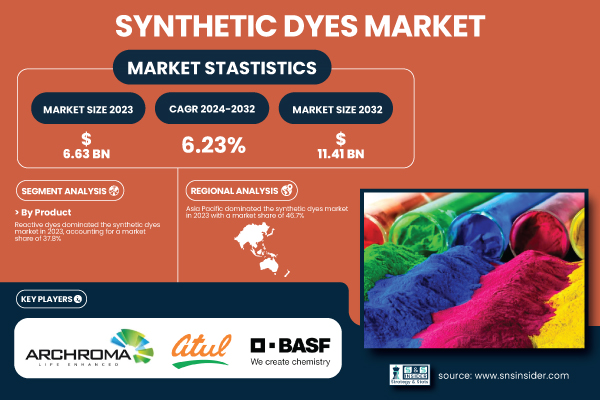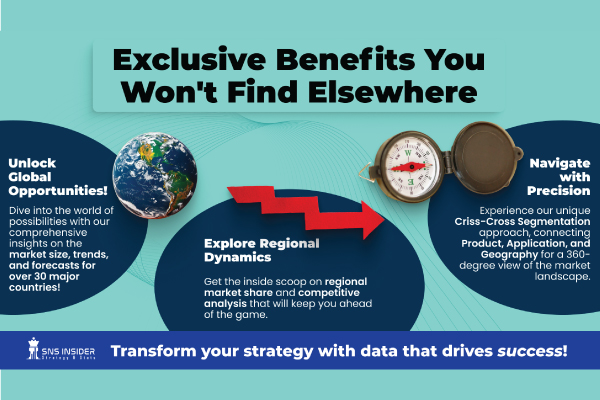Austin, May 22, 2025 (GLOBE NEWSWIRE) -- The Synthetic Dyes Market Size was valued at USD 6.63 billion in 2023 and is expected to reach USD 11.41 billion by 2032, growing at a CAGR of 6.23% over the forecast period of 2024-2032.

Download PDF Sample of Synthetic Dyes Market @ https://www.snsinsider.com/sample-request/6624
Global Shift Toward Sustainable Colorants Drives Export Growth and Innovation in the Expanding Synthetic Dyes Industry
The synthetic dyes market is witnessing strong growth driven by demand from textiles, leather, and personal care sectors for vibrant, durable solutions. Innovations like biodegradable dyes and advanced wastewater treatment are enabling compliance with strict environmental norms. Rising consumer preference for safe, high-performance products is accelerating the adoption of reactive and disperse dye technologies. In 2022, U.S. disperse dye exports hit USD 18.3 million, up 5.2% YoY, with the chemical export price index rising 2.4% between March 2023–2024. The chemical sector, including synthetic dyes, contributed over 9% to total U.S. exports in 2021, reflecting its economic significance. Additionally, the U.S. FDA approved 16 new color additives in January 2024, enhancing industry innovation. These trends underline a vibrant, innovation-led market supported by exports, pricing resilience, and favorable regulation.
The US Synthetic Dyes Market Size was valued at USD 672.71 Million in 2023, with a market share of around 70% and growing at a significant CAGR over the forecast period of 2024-2032.
The U.S. synthetic dyes market is growing steadily due to rising demand from the textile and personal care industries, alongside regulatory shifts favoring sustainable practices. Organizations like the EPA are supporting low-impact dyes, while companies like Archroma and Huntsman have introduced bio-based and non-toxic alternatives to meet eco-label certifications. Increasing fashion exports and innovation in non-textile applications (such as biomedical staining agents) further support the growth trajectory.
Key Players:
- Archroma (Reactive Blue 19, Acid Black 210, Disperse Red 73)
- Atul Ltd. (Reactive Red 195, Sulphur Black BR, Vat Blue 4)
- BASF SE (Cibacron Brilliant Red, Palanil Yellow, Irgalite Blue)
- Bodal Chemicals Ltd. (Reactive Blue 21, H Acid, Vinyl Sulfone Ester)
- Clariant AG (Remazol Brilliant Blue, Indanthren Yellow F4G, Sandoplast Red)
- DIC Corporation (Oil Red O, Lithol Rubine, Nigrosine)
- DyStar Group (Zhejiang Longsheng Group Co., Ltd.) (Reactive Blue 160, Disperse Orange 30, Acid Yellow 49)
- Everlight Chemical Industrial Corporation (Disperse Blue 56, Acid Red 183, Reactive Yellow 145)
- Hangzhou Tiankun Chem Co., Ltd. (Disperse Violet 93, Reactive Black 5, Acid Blue 113)
- Huntsman International LLC (Reactive Navy Blue RX, Disperse Black ECT, Acid Blue 25)
- Jay Chemical Industries Pvt. Ltd. (Reactive Orange 122, Reactive Blue 13, Vinyl Sulfone Orange)
- Jiangsu Yabang Dyestuff Co., Ltd. (Reactive Black 39, Disperse Red 167, Acid Yellow 194)
- Kiri Industries Ltd. (Reactive Yellow 160, Acid Red 337, Vinyl Sulphone Ester Orange)
- KIWA Chemical Industry Co., Ltd. (Acid Red 97, Disperse Blue 3, Basic Violet 10)
- LANXESS AG (Bayfast Yellow, Macrolex Red, Solvent Blue 35)
- Nippon Kayaku Co., Ltd. (Kayacelon Blue HRL, Kayacelon Yellow HR, Kayarus Blue A-R)
- Sudarshan Chemical Industries Ltd. (Sudarshan Disperse Blue 79, Disperse Violet 28, Sudarshan Acid Red 57)
- Synthesia, a.s. (Acid Blue 25, Direct Red 81, Reactive Black 5)
- Zhejiang Longsheng Group Co., Ltd. (Reactive Red 218, Disperse Blue 359, Acid Violet 49)
- Zhejiang Runtu Co., Ltd. (Reactive Blue 222, Acid Black 210, Disperse Yellow 54)
Synthetic Dyes Market Report Scope:
| Report Attributes | Details |
| Market Size in 2023 | USD 6.63 Billion |
| Market Size by 2032 | USD 11.41 Billion |
| CAGR | CAGR of 6.23% From 2024 to 2032 |
| Base Year | 2023 |
| Forecast Period | 2024-2032 |
| Historical Data | 2020-2022 |
| Report Scope & Coverage | Market Size, Segments Analysis, Competitive Landscape, Regional Analysis, DROC & SWOT Analysis, Forecast Outlook |
| Key Segments | • By Product (Reactive Dyes, Vat Dyes, Acid Dyes, Direct Dyes, Disperse Dyes, Others) • By Form (Liquid, Powder, Granular) • By End-use (Textiles, Pulp & Paper, Leather, Building & Construction, Others) |
| Key Drivers | • Adoption of Smart Textile Technologies is Elevating the Application of Performance-Driven Synthetic Dyes Across Sectors. |
Buy Full Research Report on Synthetic Dyes Market 2024-2032 @ https://www.snsinsider.com/checkout/6624
Environmental Impact of Synthetic Dyes: Key Challenges and Sustainable Solutions
- Growing demand for synthetic dyes raises concerns over water pollution from the dyeing process.
- Toxic chemicals and heavy metals in wastewater from dyeing threaten aquatic ecosystems.
- Stricter regulatory standards, like those from the EPA, are pushing for sustainable dyeing practices.
- Sustainable dye technologies, including waterless methods and plant-based dyes, are reducing environmental impact.
- Life cycle assessments (LCAs) help manufacturers adopt greener alternatives by evaluating dye impacts.
By Product, Reactive Dyes Dominated the Synthetic Dyes Market in 2023 with a 37.8% Market Share
Reactive dyes are widely used in textiles for their colorfastness, low toxicity, and compatibility with cotton. These dyes chemically bond with fibers, providing durability, making them ideal for apparel and home textiles. The booming textile industry in countries like India and China, and sustainable initiatives from major U.S. brands like Levi’s and Gap have boosted demand. Companies like Huntsman and Archroma are also developing water-saving technologies for reactive dyes, meeting global environmental standards and increasing adoption due to their long-lasting color properties.
By Form, Powder Dominated the Synthetic Dyes Market in 2023 with a 48.9% Market Share
Powdered synthetic dyes are favored for easy storage, transport, and extended shelf life. These dyes are ideal for large-scale industrial applications due to their cost efficiency and stable chemical composition. Powdered dyes are also easily soluble in water, making them suitable for bulk production. In developing countries with limited infrastructure, powders reduce spoilage risks. U.S. manufacturers like DyStar and Standard Colors Inc. have ramped up production, while e-commerce platforms cater to small-scale buyers. Sustainability efforts have further driven growth, with investments in lower-dust emission powder processing.
By End-use, Textiles Dominated the Synthetic Dyes Market in 2023 with a 61.4% Market Share
The dominance is driven by a strong post-pandemic recovery in textile exports. Synthetic dyes offer consistency and quality across large-scale fabric production, essential for apparel, sportswear, and home textiles. Fast-fashion brands like H&M, Zara, and Uniqlo rely heavily on synthetic dyes. In the U.S., initiatives from the National Council of Textile Organizations (NCTO) have stimulated demand. Growth in technical textiles for automotive, protective gear, and healthcare has further supported the segment. Rising eco-consciousness is prompting investment in sustainable dyeing methods.
If You Need Any Customization on Synthetic Dyes Market Report, Inquire Now @ https://www.snsinsider.com/enquiry/6624
Asia Pacific dominated the Synthetic Dyes Market in 2023, Holding a 46.7% Market Share
The dominance in the synthetic dyes market is driven by large-scale textile production in China, India, and Bangladesh, supported by low labor costs, extensive manufacturing hubs, and government initiatives like India’s PLI Scheme. China saw a 7% rise in textile exports in 2023, reflecting increased dye consumption. APAC firms are adopting greener dyeing technologies, aligning with sustainability goals. The region's demand for vibrant colors, quick fashion cycles, and cost-effective dyeing solutions strengthens its market leadership.
North America Emerged as the Fastest Growing Region in the Synthetic Dyes Market with a Significant Growth Rate in The Forecast Period
US dominance in the synthetic dyes market is driven by technological innovation, sustainable products, and growth in niche sectors like biomedicals and packaging. Companies like Milliken & Company and Huntsman are advancing digital dye printing and eco-friendly formulations. Consumer demand for ethical dye processes in apparel surged by 8% in 2023, according to the AAFA. Expansion in DIY and crafts, along with state-level environmental regulations, is pushing the shift toward greener dyes, fostering further innovation and adoption in the market.

Table of Contents – Major Key Points
1. Introduction
2. Executive Summary
3. Research Methodology
4. Market Dynamics Impact Analysis
5. Statistical Insights and Trends Reporting
6. Competitive Landscape
7. Synthetic Dyes Market Segmentation, By Product
8. Synthetic Dyes Market Segmentation, By Form
9. Synthetic Dyes Market Segmentation, By End-use
10. Regional Analysis
11. Company Profiles
12. Use Cases and Best Practice
13. Conclusion
Read Our Trending Reports:
Europe Holds Second Largest Share in Paper Dyes Market with 3.7% CAGR
About Us:
SNS Insider is one of the leading market research and consulting agencies that dominates the market research industry globally. Our company's aim is to give clients the knowledge they require in order to function in changing circumstances. In order to give you current, accurate market data, consumer insights, and opinions so that you can make decisions with confidence, we employ a variety of techniques, including surveys, video talks, and focus groups around the world.
